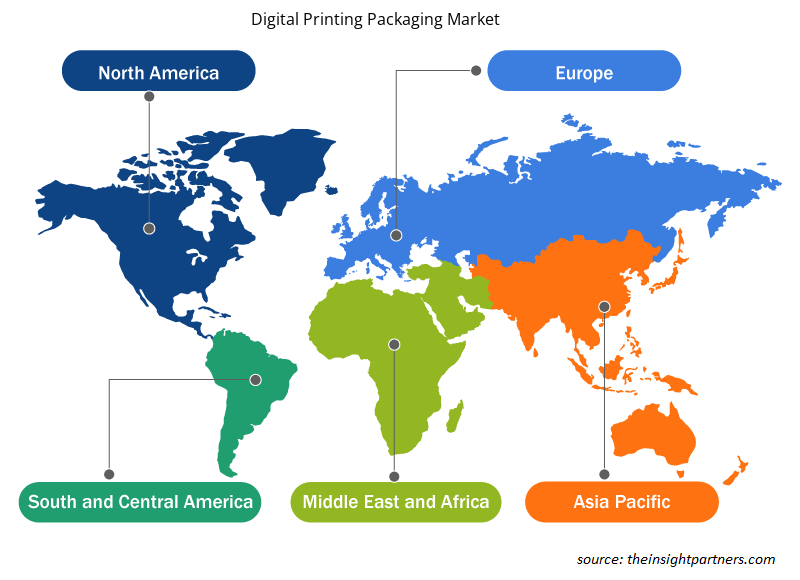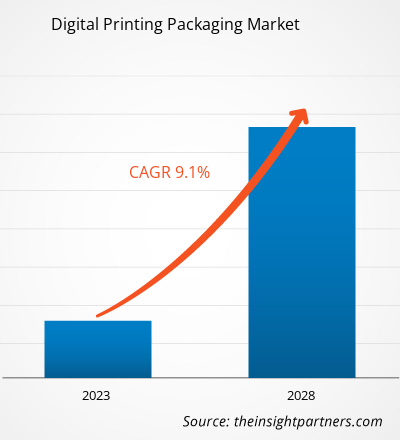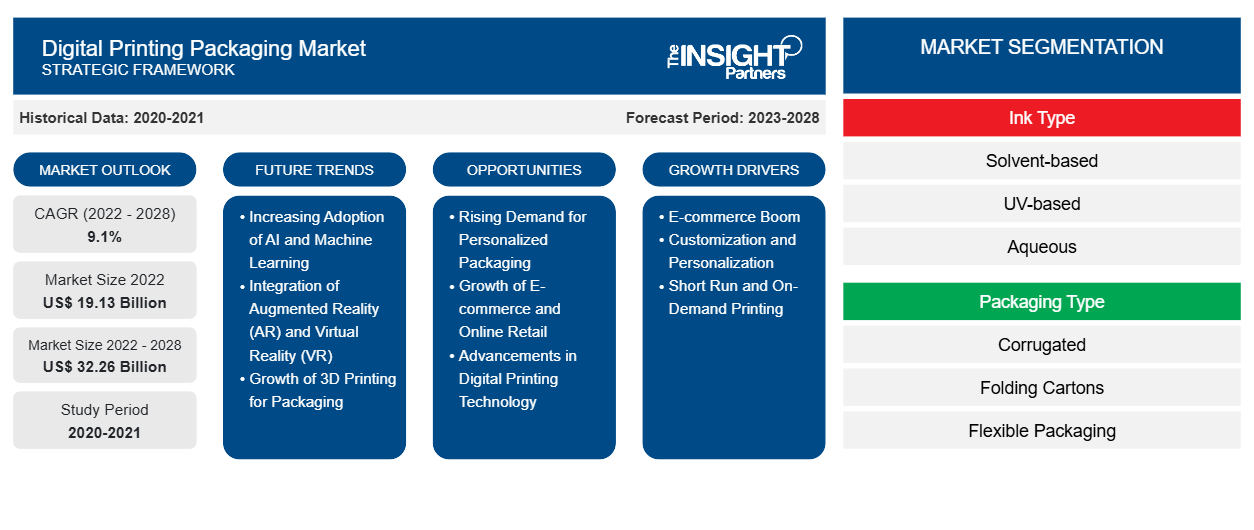من المتوقع أن يصل سوق التغليف بالطباعة الرقمية إلى 32،255.60 مليون دولار أمريكي بحلول عام 2028 من 19،131.13 مليون دولار أمريكي في عام 2022. ومن المتوقع أن يسجل معدل نمو سنوي مركب بنسبة 9.1٪ من عام 2022 إلى عام 2028.
يشهد سوق التغليف بالطباعة الرقمية نموًا متزايدًا نظرًا للطلب المتزايد على التغليف المرن والطباعة الصديقة للبيئة. وعلاوة على ذلك، أدت التطورات السريعة في تقنيات الطباعة إلى توسيع نطاق التغليف المرن والأغلفة المموجة والكرتون القابل للطي. وهناك طلب متزايد على التغليف الجذاب بالطباعة الرقمية من مختلف الصناعات ذات الاستخدام النهائي مثل الأغذية والمشروبات والأدوية والعناية الشخصية ومستحضرات التجميل. ويستثمر المصنعون في التغليف لأنه يجذب المستهلكين ويعطيهم جميع المعلومات المطلوبة.
في عام 2021، استحوذت منطقة آسيا والمحيط الهادئ على أكبر حصة من سوق التغليف بالطباعة الرقمية العالمية، ومن المتوقع أن تسجل أوروبا أسرع معدل نمو سنوي مركب خلال فترة التنبؤ. إن الطلب المتزايد على تغليف المواد الغذائية والتركيز الكبير على ملصقات الأطعمة المعبأة التي تشارك المعلومات حول عمر تخزين المنتج وتكوينه ومحتواه الغذائي هي الأسباب الرئيسية التي تعزز سوق الطباعة الرقمية في منطقة آسيا والمحيط الهادئ. في عام 2021، أصدرت مجموعة عمل منتجات الأغذية المحضرة ( PFPWG ) التابعة لرابطة دول جنوب شرق آسيا ( آسيان ) إرشادات لأنظمة التحكم في مواد ملامسة الأغذية ( FCM )، بما في ذلك مواد التغليف النشط والذكي داخل الدول الأعضاء في رابطة دول جنوب شرق آسيا (آسيان) . ومن المتوقع أن تعزز مثل هذه اللوائح الطلب على التغليف بالطباعة الرقمية في دول آسيا والمحيط الهادئ. وعلاوة على ذلك، وفقًا لمؤسسة التمويل الدولية ( IFC )، وهي عضو في مجموعة البنك الدولي، تضاعف حجم التجارة الإلكترونية في جنوب شرق آسيا ثلاث مرات بين عامي 2015 و2020، حيث نمت قيمتها إلى 105 مليار دولار أمريكي. وقد تؤدي اتجاهات مماثلة إلى زيادة أخرى في القيمة بثلاثة أضعاف، أي 309 مليار دولار أمريكي، بحلول عام 2025. وبالتالي، من المتوقع أن يعزز نمو صناعة التجارة الإلكترونية توسع سوق التغليف بالطباعة الرقمية.
قم بتخصيص هذا التقرير ليناسب متطلباتك
ستحصل على تخصيص لأي تقرير - مجانًا - بما في ذلك أجزاء من هذا التقرير، أو تحليل على مستوى الدولة، وحزمة بيانات Excel، بالإضافة إلى الاستفادة من العروض والخصومات الرائعة للشركات الناشئة والجامعات
- احصل على أهم اتجاهات السوق الرئيسية لهذا التقرير.ستتضمن هذه العينة المجانية تحليلاً للبيانات، بدءًا من اتجاهات السوق وحتى التقديرات والتوقعات.
تأثير جائحة كوفيد-19 على سوق التغليف والطباعة الرقمية
لقد أثر تفشي فيروس كورونا المستجد على جميع الصناعات تقريبًا على مستوى العالم. واضطرت العديد من مرافق التصنيع والتطوير في جميع أنحاء العالم إلى إغلاق عملياتها خلال المراحل الأولية من الوباء. ونفذت حكومات الولايات والحكومة الوطنية على مستوى العالم تدابير الإغلاق وضمنت معايير التباعد الاجتماعي للحد من انتشار الفيروس. بالإضافة إلى ذلك، أدت الأزمة المالية التي أعقبت الوباء مباشرة إلى تأخير كبير في الطرح التجاري للصناعات الدوائية وغيرها. ونتيجة لذلك، شهدت العديد من الشركات الصغيرة والمتوسطة الحجم انخفاضًا كبيرًا في الدخل. وتعتبر الصناعات العمود الفقري لمقدمي التكنولوجيا المختلفين وتحاول التعافي منذ ظهور جائحة كوفيد-19 في عام 2020. ونتيجة لذلك، واجه اللاعبون في السوق العديد من التحديات بسبب الاضطرابات التي أحدثها الوباء في سلسلة التوريد.
رؤى السوق
التطورات التكنولوجية في الطباعة الرقمية تدفع سوق التغليف بالطباعة الرقمية
في مجال التعبئة والتغليف والطباعة والوسم، تتزايد التطورات التكنولوجية بسرعة. توفر الطباعة الرقمية تخصيصًا للتغليف ومرونة الإنتاج وتوفر وقت التعبئة والتغليف للتسويق. نظرًا للتحسينات المختلفة للمعدات والتطورات التكنولوجية، يفضل أصحاب العلامات التجارية ومحولات التعبئة والتغليف الطباعة الرقمية. يقدم الابتكار في الطباعة الرقمية حلولاً للشركات لتقليل مدة الإنتاج من أشهر إلى أيام. تساعد التطورات التكنولوجية في التعبئة والتغليف بالطباعة الرقمية أيضًا في العلامات التجارية والتسويق. توفر المطبوعات المباشرة على العبوات مظهرًا فريدًا للمنتجات.
تُستخدم التغليف بالطباعة الرقمية بشكل بارز في العديد من الصناعات، بما في ذلك الأغذية والمشروبات والأدوية والعناية الشخصية ومستحضرات التجميل. ونظرًا للتطورات التكنولوجية الهامة في تقنيات نفث الحبر والتصوير الكهروضوئي، تظهر الطباعة الرقمية كواحدة من الطرق الفعالة من حيث التكلفة وسهلة الوصول للطباعة. تُستخدم التغليف بالطباعة الرقمية بشكل أساسي لتعبئة المنتجات الغذائية والمشروبات. بالنسبة للأغذية والمشروبات والسلع الاستهلاكية الأخرى، توفر تقنية الطباعة الرقمية تغليفًا عالي الجودة مع فوائد التخصيص والتحول السريع وتقليل النفايات والتعديل الفوري لتصميمات العبوات. في قطاع الأدوية والقنب، يتجه المصنعون بشكل متزايد إلى الطباعة الرقمية لتلبية متطلبات التغليف الموضعي والبيانات المتغيرة المطلوبة قانونًا والتغيير السريع والمتكرر. أتاح التقدم في المعدات طباعة مواد وتنسيقات تغليف مختلفة رقميًا، بما في ذلك أغلفة الطعام وعلب المشروبات المصنوعة من الألومنيوم والأكياس ذات الفيلم المعدني. وبالتالي، فإن التقدم التكنولوجي المتزايد في قطاع التغليف بالطباعة الرقمية يدفع نمو السوق.
رؤى تعتمد على نوع الحبر
بناءً على نوع الحبر، يتم تصنيف سوق التغليف بالطباعة الرقمية إلى قائم على المذيبات، وقائم على الأشعة فوق البنفسجية، ومائي، وغيرها. احتل القطاع القائم على المذيبات أكبر حصة في السوق في عام 2021 ومن المتوقع أن يسجل القطاع المائي أعلى معدل نمو سنوي مركب خلال فترة التنبؤ. تتكون الأحبار القائمة على المذيبات من الصبغة والراتنج (المادة الرابطة)، والتي تشكل مكونًا صلبًا للحبر، والمذيب كعامل حامل. يتم رش الحبر القائم على المذيبات على ركيزة أثناء عملية الطباعة الرقمية، مما يؤدي إلى تبخر المذيب، تاركًا وراءه طبقة جافة من الحبر. الأحبار القائمة على المذيبات غير مكلفة نسبيًا. لديها مجموعة واسعة من تطبيقات الطباعة الرقمية على ركائز متنوعة مثل الرقائق والأفلام والبلاستيك الصلب، بما في ذلك البولي روبيلين ثنائي المحور (BOPP)، وكلوريد البولي فينيل (PVC)، وبولي إيثيلين تيريفثالات (PET)، والصناديق اللامعة أو الورق المقوى، والمعادن، وغيرها من مواد البولي إيثيلين عالية الكثافة. يوفر الحبر القائم على المذيبات المتانة على BOPP وغيرها من الركائز، بما في ذلك PE وPET ورقائق الألومنيوم وPVC. يلتزم العديد من مزودي الطباعة الرقمية في جميع أنحاء العالم باللوائح الدولية والمحلية لطباعة العبوات. وقد شجع ذلك مصنعي الحبر على صياغة منتجات متوافقة لتلبية طلب العملاء. على سبيل المثال، في أكتوبر 2022، أطلقت شركة Kao Collins Inc. حبرًا قائمًا على المذيبات متوافقًا مع المرسوم السويسري بخمسة ألوان - الأحمر والأصفر والأزرق والأخضر والبنفسجي. يتم صياغة هذه الأحبار وتصنيعها وفقًا لإرشادات EUPIA (رابطة أحبار الطباعة العالمية) بشأن أحبار الطباعة.
رؤى تعتمد على نوع التغليف
بناءً على نوع التغليف، يتم تقسيم سوق التغليف بالطباعة الرقمية إلى مموج وكرتون قابل للطي وتغليف مرن وملصقات وغيرها. احتلت شريحة التغليف المموج أكبر حصة في السوق في عام 2021 ومن المتوقع أن تسجل شريحة التغليف المرنة أعلى معدل نمو سنوي مركب خلال فترة التنبؤ. تحتوي اللوحة المموجة على أقواس (تُعرف باسم الأخاديد) بين طبقتين، وتشكل عمودًا صلبًا. يقاوم هذا التصميم الهيكلي للصندوق المموج الضغط ويوفر الحماية ضد التغيرات المفاجئة في درجات الحرارة. بشكل عام، يتم استخدام الأحبار القائمة على الماء أو المائية والأحبار القائمة على الزيت والمذيبات للطباعة الرقمية على التغليف المموج. يُشهد الارتفاع في الحاجة إلى التغليف المموج بسبب زيادة الطلب من مواقع التجارة الإلكترونية. يرتبط الطلب على التغليف المموج بمبيعات التجارة الإلكترونية، حيث يشكل التغليف المموج مكونًا أساسيًا لسلسلة توريد التجارة الإلكترونية.
رؤى الصناعة القائمة على الاستخدام النهائي
بناءً على صناعة الاستخدام النهائي، يتم تقسيم سوق التغليف بالطباعة الرقمية إلى الأغذية والمشروبات والأدوية والعناية الشخصية ومستحضرات التجميل وغيرها. شكل قطاع الأغذية والمشروبات أكبر حصة سوقية في عام 2020. خضعت صناعة التغليف بالطباعة الرقمية لتحول كبير على مدار السنوات القليلة الماضية بسبب الاستخدام المتزايد لملصقات الطباعة الرقمية وحلول التغليف من قبل الشركات المصنعة وأصحاب العلامات التجارية. في الوقت الحاضر، لم يعد السعر التنافسي كافياً في سوق التغليف بالطباعة الرقمية لاختيار المنتج، حيث يبحث المستهلكون عن تجربة منتج أفضل. يهتم المستهلكون أكثر بكثير بالقيمة المضافة والتمييز في صناعة الأغذية والمشروبات، ويطالبون بأمن منتجات الأغذية والمشروبات. يطلب المستهلكون في جميع أنحاء العالم حلول تغليف مرنة للأطعمة والمشروبات التي يستهلكونها، جنبًا إلى جنب مع الملصقات الإعلامية دون المساس بجودة الطعام أو سلامته. وبالتالي، يتبنى المصنعون أحبارًا قائمة على المذيبات للتغليف بالطباعة الرقمية لصناعة الأغذية والمشروبات. تحتوي الأحبار القائمة على المذيبات على مواد كيميائية أقل ضررًا. إنها أكثر أمانًا وصديقة للبيئة من أحبار الأشعة فوق البنفسجية أو المذيبات أو الحبر السائل. لقد أدت كل هذه العوامل إلى تغيير نموذج التغليف بالطباعة الرقمية. ويركز المصنعون بشكل مكثف على الابتكارات التكنولوجية في تصنيع التغليف بالطباعة الرقمية والطباعة ثلاثية الأبعاد.
تشمل الشركات الكبرى العاملة في سوق التغليف بالطباعة الرقمية شركة HP، Inc.؛ وXerox Holdings Corp.؛ وReel Appeal Ltd.؛ وMondi Plc؛ وDuPont De Nemours، Inc.؛ وXeicon BV؛ وQuantum Print and Packaging Ltd.؛ وWeber Packaging Solutions، Inc.؛ وDS Smith Plc. وتؤكد هذه الشركات على إطلاق منتجات جديدة والتوسع الجغرافي لتلبية الطلب المتزايد من المستهلكين في جميع أنحاء العالم. ولديها حضور عالمي واسع النطاق، مما يتيح لها خدمة مجموعة كبيرة من العملاء وبالتالي زيادة حصتها في السوق. وتركز هذه الشركات بشكل كبير على إطلاق منتجات جديدة والتوسع الإقليمي لزيادة نطاق منتجاتها في محافظ المنتجات المتخصصة.
رؤى إقليمية حول سوق التغليف بالطباعة الرقمية
لقد قام المحللون في Insight Partners بشرح الاتجاهات والعوامل الإقليمية المؤثرة على سوق التغليف بالطباعة الرقمية طوال فترة التوقعات بشكل شامل. يناقش هذا القسم أيضًا قطاعات سوق التغليف بالطباعة الرقمية والجغرافيا في جميع أنحاء أمريكا الشمالية وأوروبا ومنطقة آسيا والمحيط الهادئ والشرق الأوسط وأفريقيا وأمريكا الجنوبية والوسطى.

- احصل على البيانات الإقليمية المحددة لسوق التغليف بالطباعة الرقمية
نطاق تقرير سوق التغليف بالطباعة الرقمية
| سمة التقرير | تفاصيل |
|---|---|
| حجم السوق في عام 2022 | 19.13 مليار دولار أمريكي |
| حجم السوق بحلول عام 2028 | 32.26 مليار دولار أمريكي |
| معدل النمو السنوي المركب العالمي (2022 - 2028) | 9.1% |
| البيانات التاريخية | 2020-2021 |
| فترة التنبؤ | 2023-2028 |
| القطاعات المغطاة | حسب نوع الحبر
|
| المناطق والدول المغطاة | أمريكا الشمالية
|
| قادة السوق وملفات تعريف الشركات الرئيسية |
|
كثافة اللاعبين في السوق: فهم تأثيرها على ديناميكيات الأعمال
يشهد سوق التغليف بالطباعة الرقمية نموًا سريعًا، مدفوعًا بالطلب المتزايد من المستخدم النهائي بسبب عوامل مثل تفضيلات المستهلك المتطورة والتقدم التكنولوجي والوعي المتزايد بفوائد المنتج. ومع ارتفاع الطلب، تعمل الشركات على توسيع عروضها والابتكار لتلبية احتياجات المستهلكين والاستفادة من الاتجاهات الناشئة، مما يؤدي إلى زيادة نمو السوق.
تشير كثافة اللاعبين في السوق إلى توزيع الشركات أو المؤسسات العاملة في سوق أو صناعة معينة. وهي تشير إلى عدد المنافسين (اللاعبين في السوق) الموجودين في مساحة سوق معينة نسبة إلى حجمها أو قيمتها السوقية الإجمالية.
الشركات الرئيسية العاملة في سوق التغليف والطباعة الرقمية هي:
- شركة اتش بي
- شركة زيروكس القابضة
- شركة ريل ابيل المحدودة
- شركة موندي المحدودة
- شركة دوبون دي نمور
إخلاء المسؤولية : الشركات المذكورة أعلاه ليست مرتبة بأي ترتيب معين.

- احصل على نظرة عامة على أهم اللاعبين الرئيسيين في سوق الطباعة والتغليف الرقمي
تقرير يسلط الضوء على
- اتجاهات الصناعة التقدمية في سوق التغليف بالطباعة الرقمية لمساعدة الشركات على تطوير استراتيجيات فعالة طويلة الأجل
- استراتيجيات نمو الأعمال التي يتبناها لاعبو سوق التغليف بالطباعة الرقمية في البلدان المتقدمة والنامية
- التحليل الكمي للسوق من 2020 إلى 2028
- تقدير الطلب العالمي على التغليف المطبوع رقميا
- تحليل قوى بورتر الخمس لتوضيح فعالية المشترين والموردين في سوق التغليف بالطباعة الرقمية
- التطورات الأخيرة لفهم سيناريو السوق التنافسي
- اتجاهات السوق وتوقعاتها، فضلاً عن العوامل التي تدفع وتكبح نمو سوق التغليف بالطباعة الرقمية
- المساعدة في عملية اتخاذ القرار من خلال تسليط الضوء على استراتيجيات السوق التي تدعم المصلحة التجارية
- حجم سوق التغليف بالطباعة الرقمية في مختلف العقد
- نظرة عامة مفصلة وديناميكيات صناعة التعبئة والتغليف بالطباعة الرقمية
- حجم سوق التغليف بالطباعة الرقمية في مناطق مختلفة مع فرص نمو واعدة
- التحليل التاريخي (سنتان)، سنة الأساس، التوقعات (7 سنوات) مع معدل النمو السنوي المركب
- تحليل PEST و SWOT
- حجم السوق والقيمة / الحجم - عالمي، إقليمي، بلد
- الصناعة والمنافسة
- مجموعة بيانات إكسل
التقارير الحديثة
تقارير ذات صلة
شهادات العملاء
سبب الشراء
- اتخاذ قرارات مدروسة
- فهم ديناميكيات السوق
- تحليل المنافسة
- رؤى العملاء
- توقعات السوق
- تخفيف المخاطر
- التخطيط الاستراتيجي
- مبررات الاستثمار
- تحديد الأسواق الناشئة
- تحسين استراتيجيات التسويق
- تعزيز الكفاءة التشغيلية
- مواكبة التوجهات التنظيمية





















 احصل على عينة مجانية ل - سوق التغليف والطباعة الرقمية
احصل على عينة مجانية ل - سوق التغليف والطباعة الرقمية